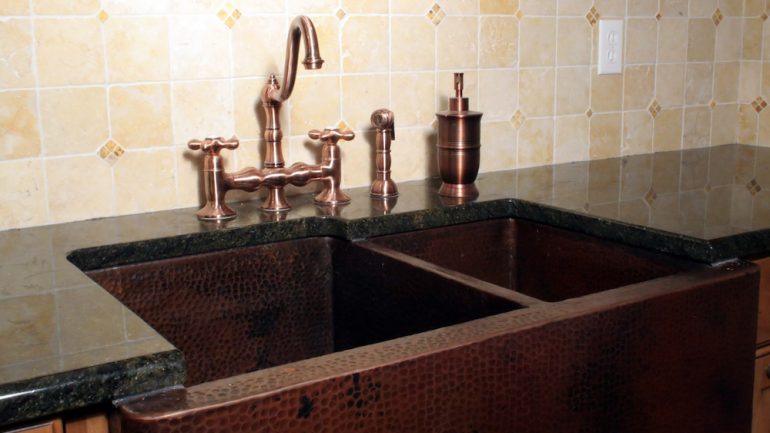When you are building out a new kitchen, you’ve got lots of great choices when it comes to your sink. The many materials from which kitchen sinks are made allow you to create just the right look and functionality. Here’s our guide to the pros, cons and pricing of seven kitchen sink materials.
Stainless steel
Clean, lightweight and affordable, stainless steel is a popular choice for kitchen sinks. You don’t have to settle for the standard silvery stainless steel look, either. Stainless steel sinks are available in gold, black and pewter, among other colors. Buy one with 16- to 18-gauge thickness for durability.
The downside of stainless steel? It scratches easily, and over time, wear and tear will show. Choosing brushed and nickel finishes help camouflage the inevitable scratches. Sink saving tip: Purchase a stainless steel grid that lays in the bottom of the sink to protect it from scratches as well as the bangs and clangs associated with these sinks. To dampen noise, look for models with sound-absorbing material on the outside of the basin beneath the sink. Stainless steel kitchen sinks run from around $100 to more than $800.
Solid surface
The next most affordable sink material is a solid surface made up of composite acrylic material, such as Corian®. These sinks mimic the look of iron-covered enamel without the weight. Though this material is affordable, be sure to spend enough to get the higher-quality acrylics that resist staining. Cheaper acrylics can look worn in a year. Solid surface sinks start at less than $200.
Composite materials
Composite sinks are made of a ground mineral, such as granite or quartz, mixed with resins. Composites are tough and withstand heavy use. They do not show stains or scratches easily, especially in darker colors. Extreme heat can damage this sink material. These sinks can crack in transit, so Inspect them before installation for damage. Composite sinks cost between $200 and $400.
Enamel-coated cast iron
Cast-iron sinks are like a tank: strong, heavy and tough. Your grandmother may have had a cast-iron sink coated in white enamel. The enamel can scratch and stain, so don’t use abrasive cleaners or sponges on these kitchen sinks. Mild vinegar can be used to lift coffee and wine stains. Because of their weight, cast-iron sinks need to rest on strongly reinforced cabinet framing. Cast-iron enamel sinks start at $300 and run to $800.
Fireclay
A fireclay sink is an alternative to cast-iron enamel. These sinks are made of clay fused with a glaze that is kiln-baked at high temperatures. The result is a tough, durable and handsome addition to your kitchen. Fireclay is heavy enough to require strong cabinet framing, but not quite as heavy as cast iron or stone. Fireclay sinks are typically white or eggshell but are also available in black and blue. Your budget will be black and blue as well if you choose a fireclay sink, since these start at around $600 and can top $1,500.
Stone
Stone sinks are eye-catching beauties in the kitchen. Unlike a composite sink, stone sinks are carved from a single piece of quartz, slate, granite or marble. The stone is sealed at the factory, providing protection from staining and scratches. You must use only cleaners approved for the type of stone you have. Stone sinks are very heavy, and the cabinet frame must be stout. Prices for stone sinks start at around $1,000.
Copper
We saved the best for last. A copper sink is an elegant and distinctive showpiece. These sinks can be hammered or have a smooth finish. In addition to beauty, copper offers antimicrobial qualities. Be sure your copper has been mixed with zinc, and choose a 16- to 18-gauge thickness to be tough enough to withstand robust use. Prices run from around $600 to $1,200.
Related – Take a Look at Latest Trends in Kitchen Faucets


